Scientists can’t explain new findings inside the world’s most majestic caves
Science
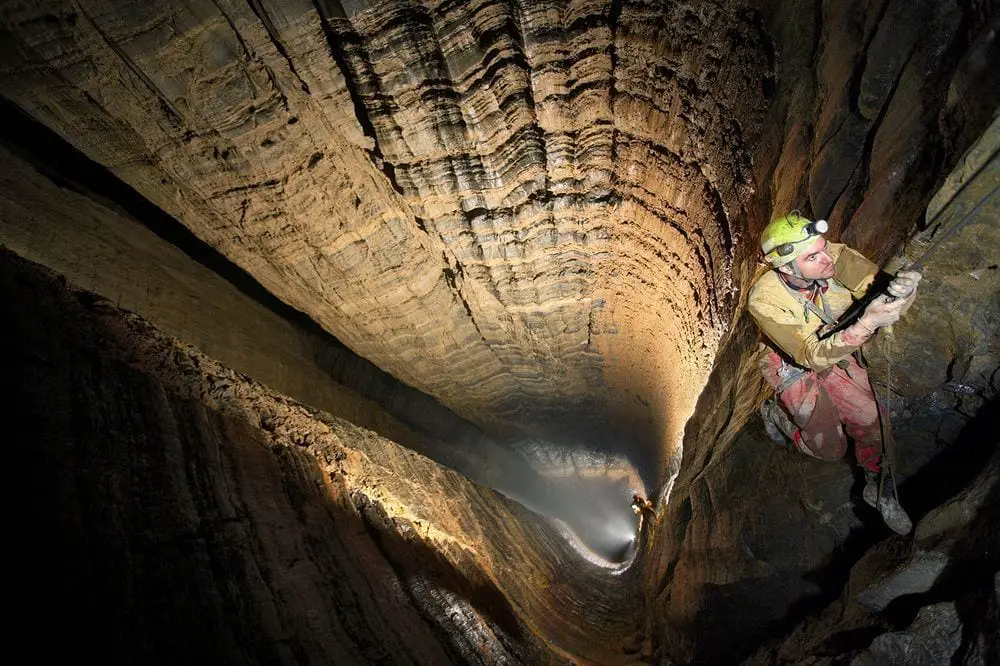
1. Ancient life in weird cave
Reddit
Caves have perplexed scientists for centuries. They contain the corpses of ancient bodies, burial grounds of our Neanderthal cousins, and even tiny, little humans that don’t exist anymore. But some of these caves contain mysteries the likes of which science has yet to observe. Here, we intend on exploring what the world of science has and has not understood in these cryptic depths. Prepare yourself.
In this cave, scientists found life embedded within giant crystals. For the most part, the life was single-celled bacteria. They didn’t, for instance, find macroscopically large caribou. But that’s to be expected. The life they did find they suspect to be something around 50,000 years old.

Facebook
The cave where they found this life was located in Naica, Mexico. These bacteria and other microbes thrived in cave by digesting minerals like iron and magnesium that existed within the crystal formations. The finding of these bacteria is thought to broaden the ranges of conditions under which we think life is able to flourish.
2. Underwater lemurs
At an underwater cave in Madagascar, divers found the bones of giant lemurs. Some of these lemurs are claimed to have big as big as gorillas. It’s not clear how the bones got to these underwater caves, however. Scientists suspect they may have been washed there by currents.
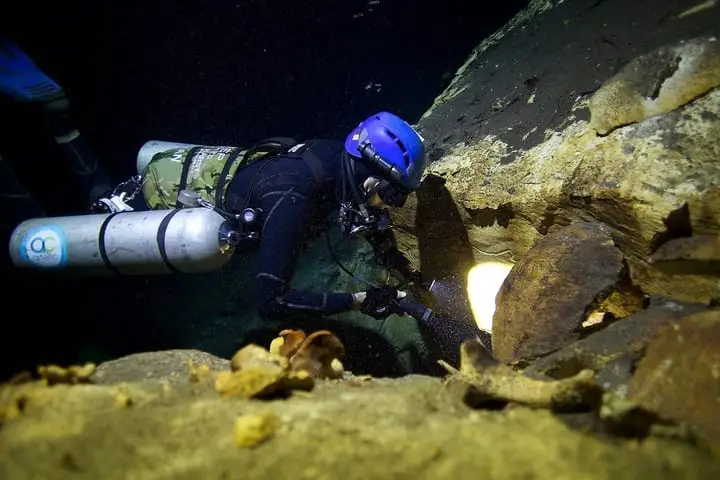
University of Massachusetts News
The ancient world before humans held all sorts of giant creatures, so giant lemurs aren’t much of a surprise. We had giant dragonflies, giant ostrich-like things, and giant deer measuring over 10 feet tall. These formidable creatures are just one testament to the awesome power of evolution. We’re lucky to have found them at all.
3. A bottomless pit
Some caves have a final boss at the end. Others, as we’ve seen, have giant lemurs. This cave, on the other hand, didn’t have an end. Okay, it really did. But the pit in Ellison’s Cave is indeed home to one of the longest known drops at its terminus. This drop measured over a staggering 586-foot descent. That’s roughly half the height of the 102-story Empire State Building.
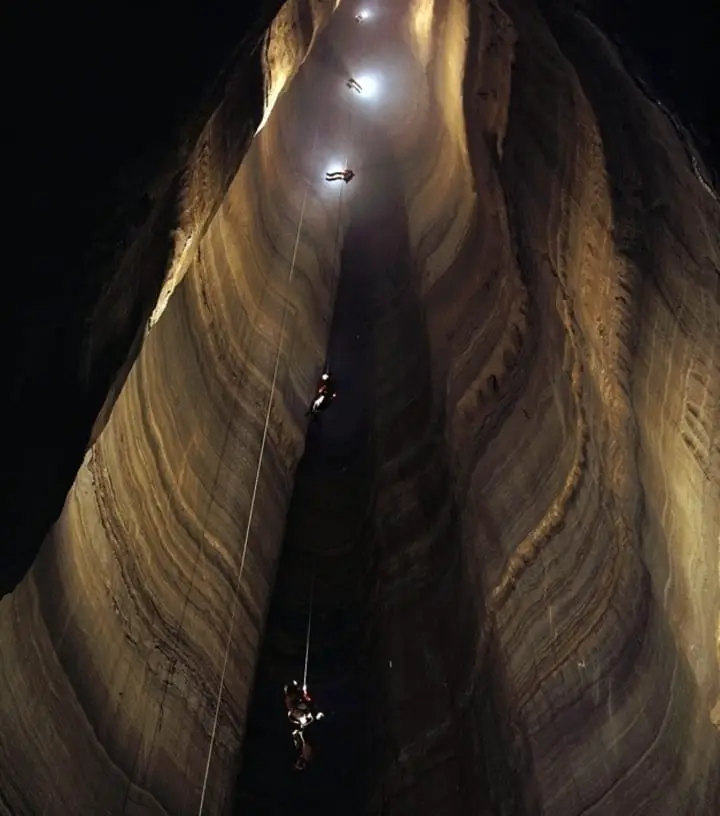
The Something Awful Forums
To get to the massive and dizzying descend, you have to spelunk through 12 miles of sinuous and often perilous cave. This cave is pitch black and full of twists, turns, and meanders that will have you reeling. But, if you make it through the miles of ominous darkness, you come across this cave’s 586-foot deep drop. This pit makes Ellison’s Cave in Northwest Georgia the 12th deepest in all North America.
4. Glowing worms
We’ve all seem images of phosphorescent bacteria and the like inhabiting the bulbs of angular fish, the tides of certain oceans, and other interesting glowing things. Here, we have them lining the walls of caves. Looking like a beautiful starlit night, these glowing orbs dangling from the ceiling are aimed to catch their next meal—flying insects.
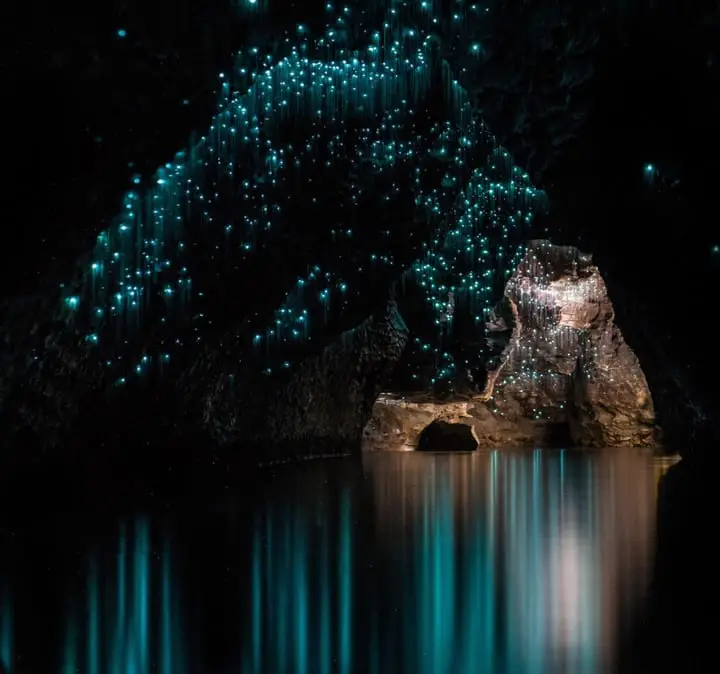
Inhabitat
This cave in Waitomo, New Zealand has an abundance of said worms. This cave was formed 30 million years ago and frequently runs kayaking tours. If you would like to see the dangling orbs, then, it needn’t take more than a ticket to New Zealand and a few hours of kayaking.
5. Snottite
This stringy, gooey substance has a name fitting for its texture and consistency—snottite. With a consistency like mucous, this gooey muck hangs waiting to trap insects that fly by. This substance was originally discovered in a cave in Tabasco, Mexico. It’s not an ingredient in the sauce, don’t worry.
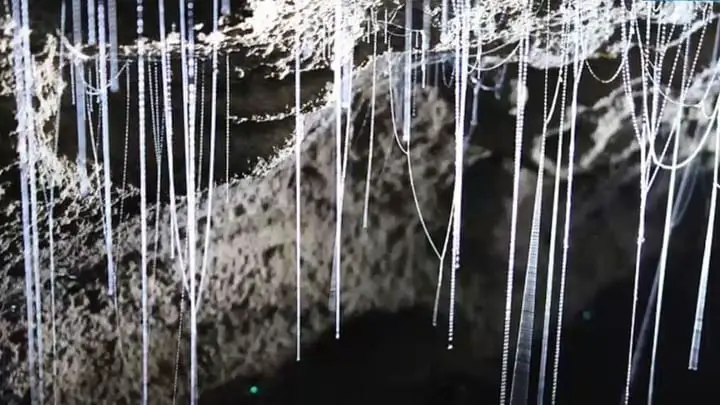
Weather
Apparently, this stuff is just a bunch of bacterial mats arranged such that they drip and dangle from the ceiling. The stuff has the consistency of mucus, which is gross. The bacteria is considered extremophilic, because of the extremely taxing environments in which it’s found to thrive. You and I, for instance, cannot thrive under the same conditions.
6. Bats
Everybody knows that bats live in caves. And in the Barangay Tambo, Samal Island, they live in abundance. This particular cave houses the Monfort Bat Sanctuary, a sanctuary with enough bats to make Dracula quiver. Unremarkable in depth, however, this cave only extends about 245 feet deep. With what’s to come, you’ll realize that’s really nothing in comparison.
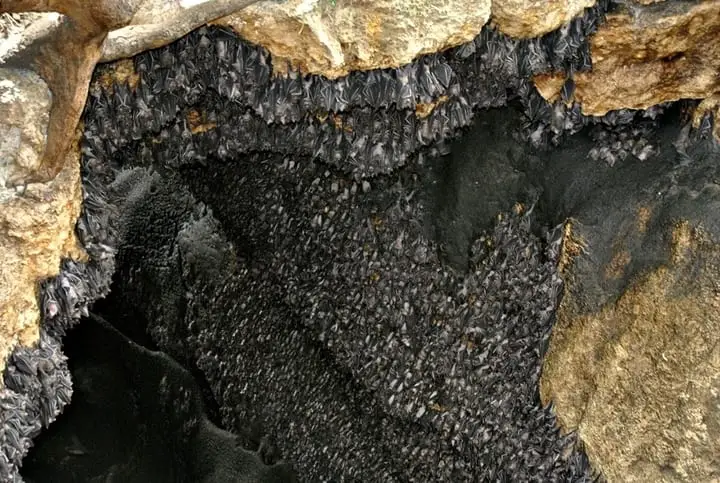
Philippian Lifestyle News
Bats are one of those creatures we know very to have adapted to the cave life. They’ve adapted to the darkness of cave life by developing a finely tuned system of echolocation. This allows them to detect the details of their surroundings with soundwaves. They ricochet from the walls and pillars of their surrounds and they use the delays of the reflected waves to ascertain distances and speeds.
7. Caves of Death
These caves (part of the larger Smoo Cave) are located in Northern Scotland. And no, they’re not named after that scene of that Mel Gibson movie in which he yells “Freedoommmm!” before meeting his heroic demise. Instead, they’re named for the remains that scientists have found inside of them: bones that indicate human sacrifice.
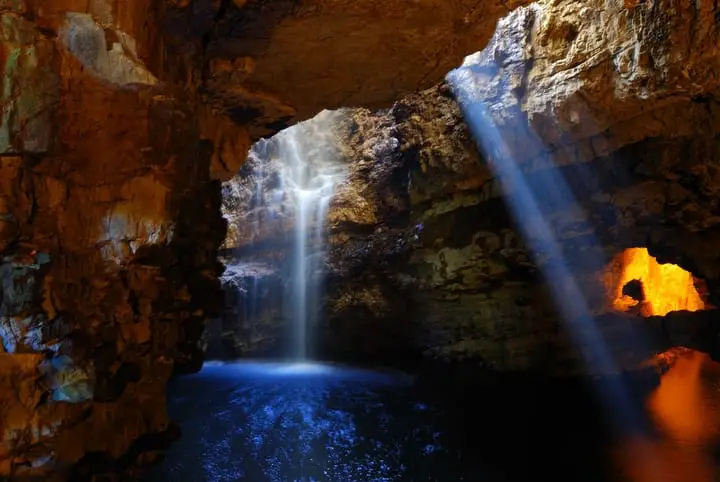
Flickr
What evidence of sacrifice did they find, you ask? Well, the creepiest stuff you can imagine. They found heads on pikes, bodies in pits, and all that awful jazz. Fortunately, these caves are notoriously challenging to navigate. If you want to find these dismembered and discarded bodies, then, you’ll have to travel through some unnavigable terrain. This is probably for the best.
8. Olm Salamander
Some of the weird things we find in caves are strangely beautiful. The aquatic salamander is one such thing. It’s blind, yet colored with pigments that would make it stare with sultry wonder. What’s more? It breeds in the water, swims in the water, and uses electrosensation to understand its surroundings. It can also live past 100 years.
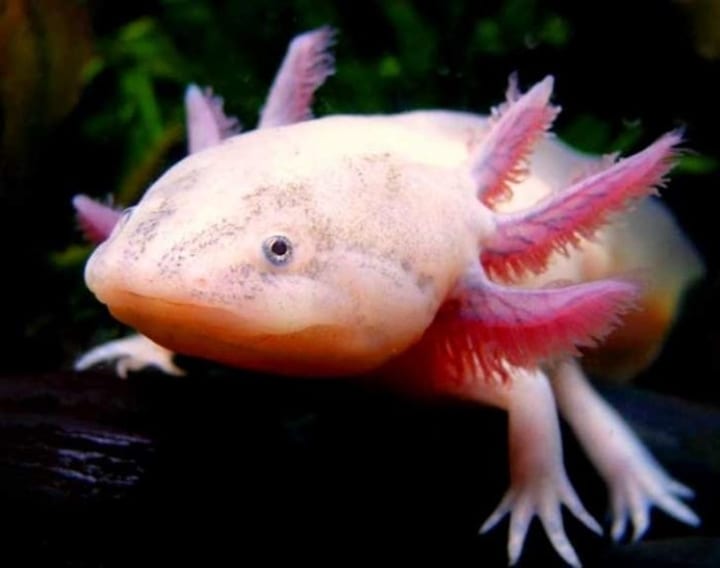
Het Diertje Van De Dag
The little critter lives in the caves of Slovenia and Croatia. Its skin is pale and pink, a piquant combination of pallid and posh. It maintains its original gills until its death, which makes it exceptionally weird among amphibian creatures. Normally, as we age we shed our younger parts. But not the olm!
9. A poisonous cave
In Romania, you’ll find more than ghosts, ghouls, and vampires. In Constanta, for instance, a country near the Black Sea, you’ll find some poisonous caves. This cave has remained untouched for almost 5.5 million years. And in these millions of years, life has adapted to its weird and surprisingly inhospitable environment.
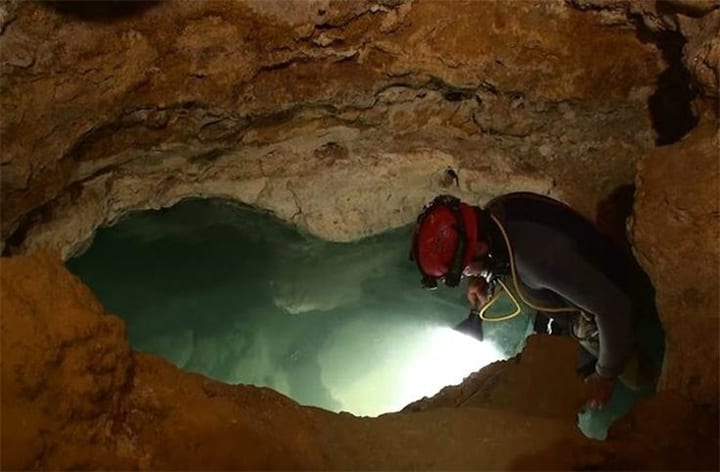
Pinterest
For the most part, the cave hosts animals like scorpions, spiders, and centipedes—gross things that most of us would squeal at were we to see them in real life. The cave’s real name: Movile Cave. Inside its darkness, you’ll find a lake that smells like rotten eggs and burnt sulfur. When perturbed, it will emit hydrogen sulfide, a poisonous gas.
10. A poisonous cave: part two
To explore the rest of this cave, scientists have to plunge into the dark and poisonous depths of these waters. What makes things more difficult is that the atmosphere of the cave has a lower amount of oxygen than normal—by about half. This means that without a breathing apparatus that provides extra oxygen, you will quickly develop a headache, become hypoxic, and die.

Unbelievable Facts
Because of these conditions, you can also only stay in the cave for a couple of hours. Our bodies are not adapted to life in the poisonous Romanian depths. But, unlike like us, numerous other species have taken to their solemn silence. What’s striking, however, is that the more inhospitable the cave’s environment becomes for us, the more variations of life you will find.
11. A poisonous cave: part three
Since no sunlight gets into the cave, the ecosystem has to function entirely bereft of its rays. This is the case with any animals living sequestered from light. The bacteria in this cave, for instance, get their carbon dioxide just like plants do—just from places other than sunlight. This is the only place on Earth where this is known to happen.
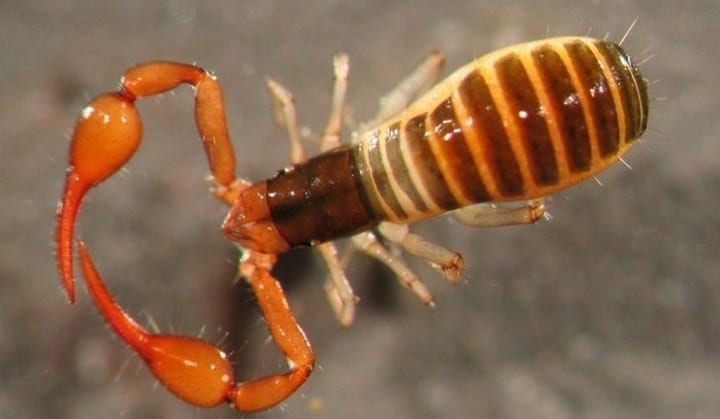
World Atlas
And how, you ask, do they do it? They break down the chemicals in the air. Certain bacteria, for instance, break down sulfur into sulfur dioxide. The increasing presence of this sulfuric acid is actually causing the limestone of the cave to erode even further, which is causing the cave to expand and grow.
12. Baja Spider
Spiders are some of the most terror-inducing species to exist. They’re creepy, they’re crawly, they’re all around terrible. But some of these species are more terrible than others. The Baja spider is one such species. Found in the deep, dark caves of places like the Sierra Cacachila mountain ranges, these spiders linger on walls waiting for prey.
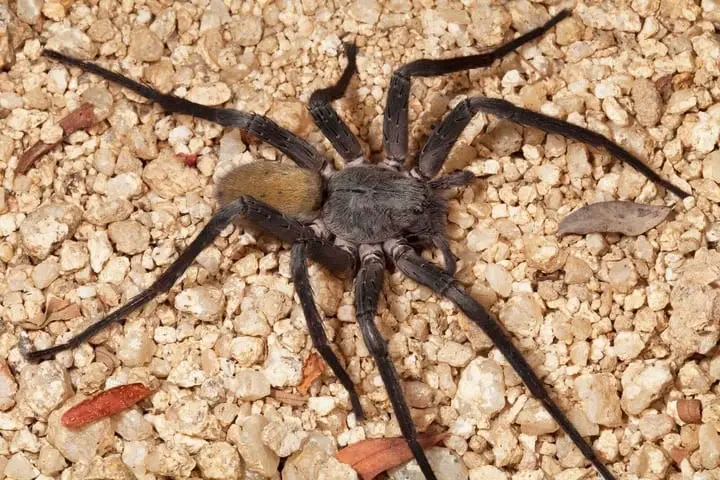
San Diego Tribune
The spider is big—terrifyingly big. It measures about four inches in length from leg to leg. That’s about the size of an iPhone. What’s even scarier is that it’s a close relative of the Brazilian wandering spider which is, as noted by the Guinness Book of World Records, the most poisonous spider currently known to exist.
13. Blue holes
Sometimes caves aren’t always on land. Sometimes they’re submerged deep underwater. In the Bahamas, for instance, there are numerous caves that lurk beneath the crystalline blue waters. The Bahamas, in fact, have the highest abundance of these underwater caves in the world.
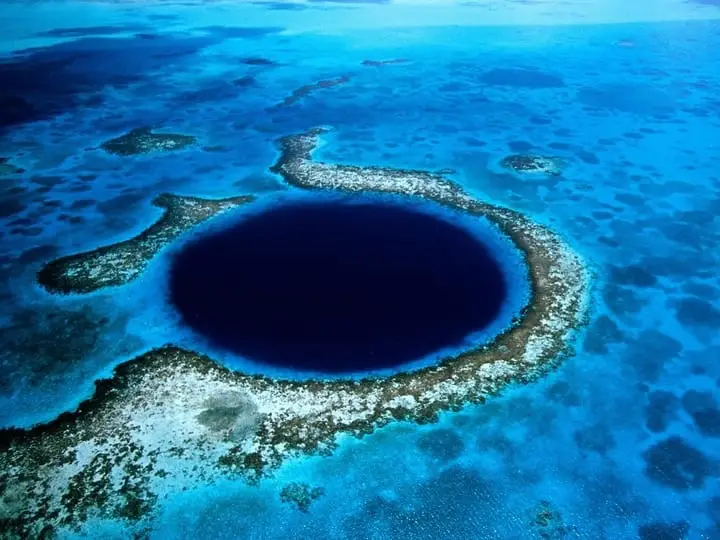
BoondockZayne’s
These holes get their name from the way they look from above. Typically, they maintain a different shade of blue than everything that surrounds them. This is because their entrances trap light and cause the water near them to reflect a darker shade of blue. If you want to find some of these, then, a drone might help.
14. Lakes
Some caves exist as a hybrid between land and sea. Sometimes, for instance, you’ll have an entire lake inside a cave. The Melissani is one such cave. It’s off the Greek island of that same name, enabling tourists and locals the ability to explore the cave via canoe and kayak.
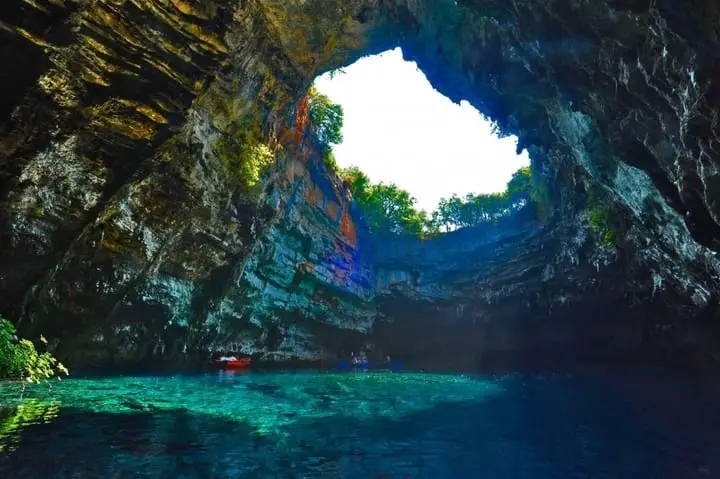
Iconic Villas
The cave’s waters are clear, limpid, and beautiful. If you’re looking for more natural beauty on your next trip to Greece, then I would recommend you take a trip to this cave. Not only will you get a nice trip down some beautiful waters, but you’ll also get the opportunity to check another cave off your list.
15. Stalactites
Stalactites are one of those features most of us think of when we think of caves. They hang from the ceiling and are formed by sediment-heavy water dripping endlessly from little rock formations. After enough time, these sediments will form addendums to the rock formations, elongating them into the pillars we call stalactites.
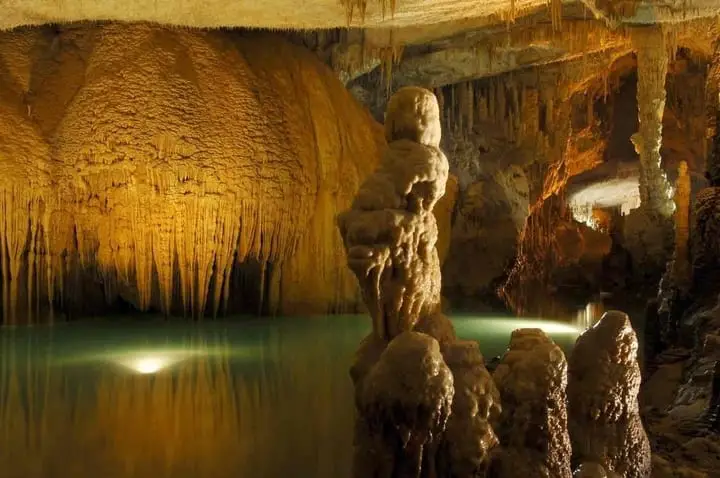
Beiruting Lifestyle
The longest of these stalactites are found in the Jeita Grotto in Lebanon. The longest of these measures to be about 27 feet in length. Since these stalactites grow at a length of about .13mm a year, these had to be growing for quite the long time.
16. Paintings
Caves are replete with mystery—and not usually the bad kind. Some caves, for instance, have revealed to us many a detail about ancient civilizations. In this particular Argentinean cave, they’ve shown their prodigious abilities to create art. What we see is their expression through dozens of handprints expressed in red chalk powder.
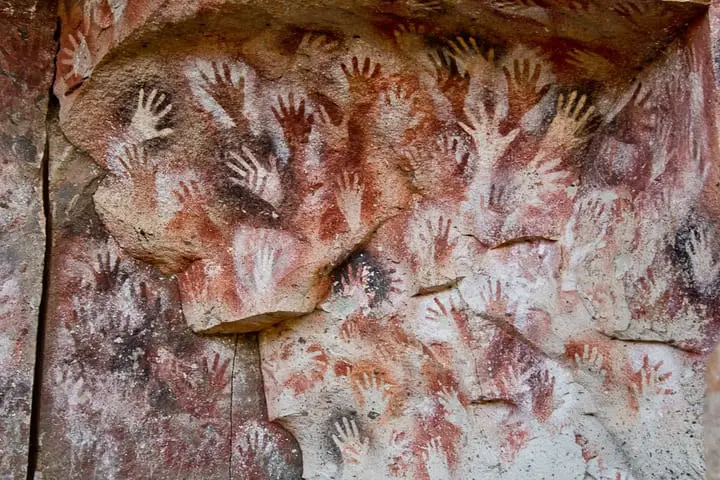
Time Travel Turtle
These paintings are found to be around 9,500 to 13,000 years old. Their prehistoric quality show not only that humans liked to express themselves in artistic ways before the modern day (thank goodness we didn’t need iPhones), but that we also liked to do it in interesting and beautiful places.
17. Stalagmites
Stalagmites are the evil, dark cousins of stalactites. Well, in reality, the only difference between the two is that stalagmites get their mineral deposits dripped onto them, not dipped off of them. This means that they aggregate water by getting dripped on. I would venture to say that is the grosser of the two.
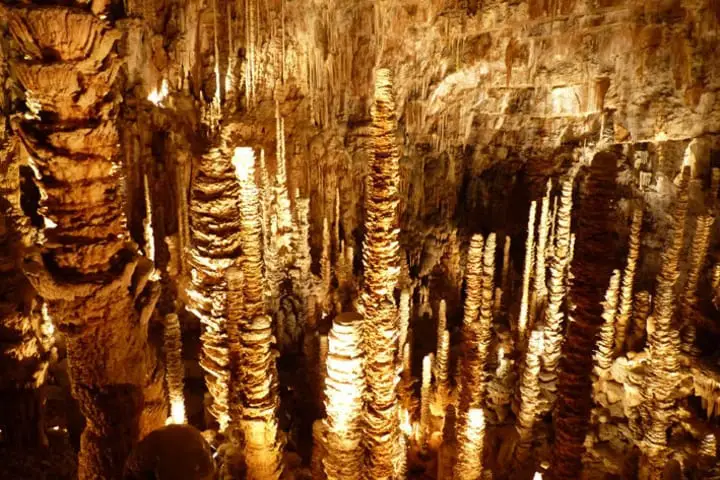
ComplexMania
The longest stalagmite in existence is found in the Doolin Cave in Claire, Ireland. This stalagmite comes in at a height of around 21 feet. That’s about as long as George Washington’s nose on Mount Rushmore. If you want to see some impressive cave growths, then, I suggest you make your way on over to Ireland.
18. Dead sea scrolls
This cave in the Judean desert housed much more than lakes or creepy, glowing bacteria. What did it house, exactly? Evidence of the coveted Dead Sea Scrolls. While the scrolls themselves weren’t found, there were other artifacts buried within a cave of one of the cliff faces in this mountain range.
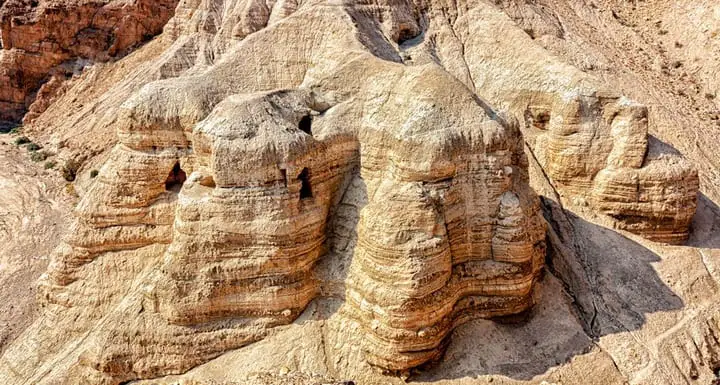
Science News
Apparently, the scrolls were looted long before they were discovered in 2017, which suggests a lot more could have been found had the caves been explored earlier. Of the actual manuscripts that they did find, the first was found in 1947. It contained texts of the 4th century BC and 2nd century AD. All the texts were written on papyrus and animal skin.
19. Neandertal and their society
In this cave in France, evidence was found of Neanderthal structures. These Neandertals had used the cave’s stalactites and stalagmites to build structures for seances or whatever other creepy things Neanderthals were doing with their time. It seems they were using the caves for some type of ritual-like gatherings.

Big Think
In this particular cave, they had used over 400 of these stalagmites and stalactites to build their effigy chambers. For the most part, they created things like room-sized rings and pyres. While we’re not certain what these guys were doing with these circular structures, we do know it is a superbly fascinating insight into their culture.
20. Ancient jewelry
In another cave, they found actual jewelry made by Neanderthals. This jewelry, for the most part, consisted of painted shells and other aquatic post-life. Researchers also found Neanderthal art in that same cave, which dated back to a time around 64,000 years ago. The cave where all this was found was called the Cueva de Los Avinoes.
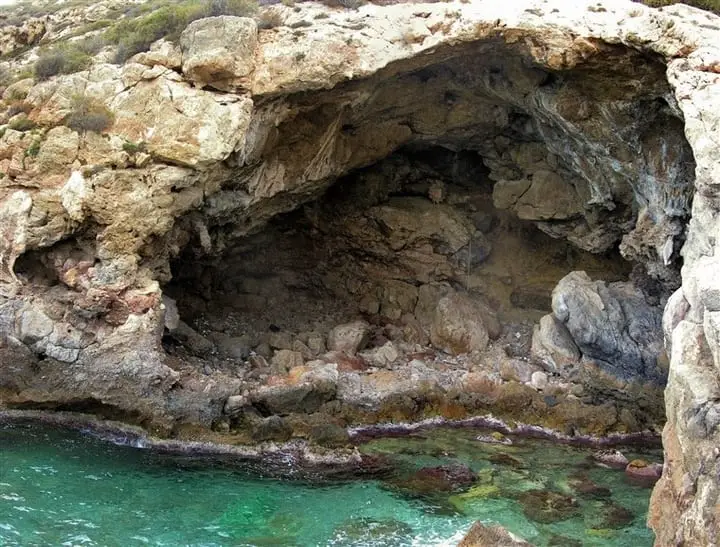
NBC
The jewelry was dated to be even older—around 115,000 years old. The art in the cave art is some of the oldest ever found. To put this in perspective, this jewelry was created around 20,000 years before anatomically modern humans had arrived in Europe from Africa. That’s pretty old.
21. Hobbits and their homes
Amazingly, a new species of human was found in this Indonesian cave. The humans, as it turned out, were quite small. Measuring at an astonishing three feet tall, this species was abnormally short. The name of these species is Homo floresiensis. They got this name because they were found off the Indonesian island, Flores. The cave is called Liang Bua.
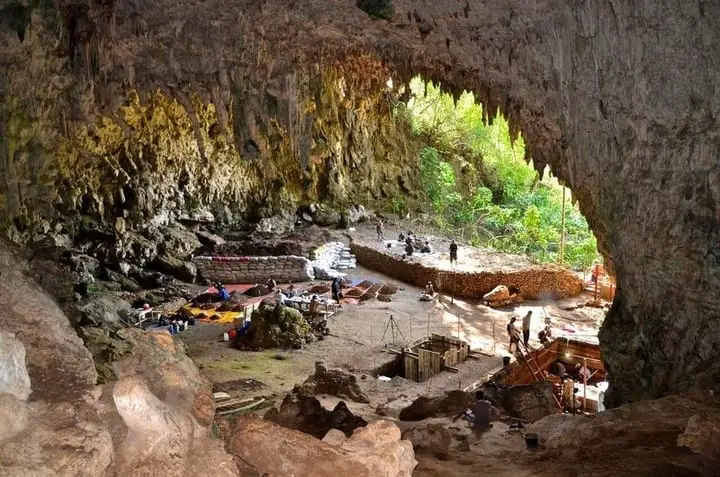
Radio New Zealand
These guys and gals were initially thought to have lived until around 12,000 years ago. But new research is showing that they instead had died out something like 50,000 years prior to the Neanderthals. This new research paints them to actually be something like 100,000 to 60,000 years old.
22. Ancient cannibals
In this Spanish cave, scientists found evidence of Neanderthal-induced cannibalism. At least 30 bones in the site have been found that were broken, dented, or crushed in ways that suggest cannibalism. They’d been sawed through, for instance, or chewed on. All was left for us future generations to ponder over in the strange cultural habits of this long-lost tribe.
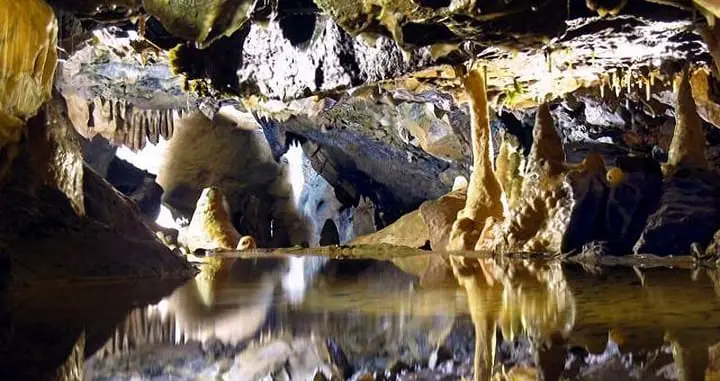
New Historian
More specifically, these bones showed signs of having been worked at with stone tools, some having been cooked, others showing teeth marks. The bones are thought to be something around 10,000 years old. Scientists think the violence and cannibalism were leveraged not for nutrients but as an intimidating tactic against other competing groups.
23. New, old humans
In one particular cave in Africa, the single largest discovery of skeletal bones has been found. And what’s unique about these bones is that they were not of any known species of modern human. In fact, they were of a previously undiscovered ancient and unknown human.
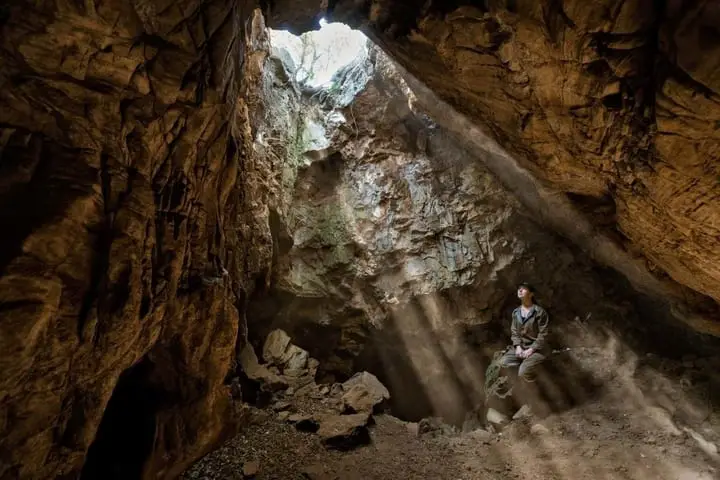
Bhavanajagat
The species has been given the name Homo naledi. While scientists haven’t yet pinpointed an exact age for this species, they do suspect that it lived something like three million years ago. Among the things that distinguish this homonid species from others is the shape of its skull. It had a smaller brain cavity and more pronounced brow ridge.
24. Air raid shelter
The Karst Cave in China is undoubtedly one of the more beautiful caves in existence. The composition of its rock reflects blended colors of purple and blue. Also called the Reed Flute Cave, this particular formation was created by an ancient river sometime around 500,000 years ago. It looks a little like something out of Charlie and the Chocolate Factory.
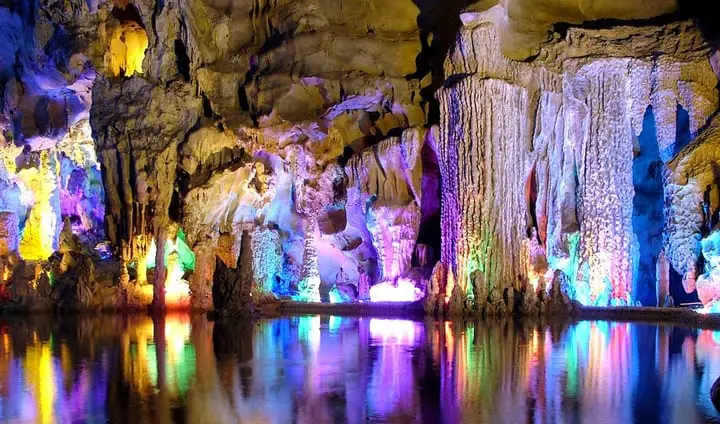
World for Travel
What’s unique about this specific cave, however, is that it was used as a bomb shelter during WWII. Due to the cave’s high accessibility, hiding from raining bombs and gunfire was easy. And this is exactly what these Chinese soldiers would do when the sirens came blaring.
25. Cave pearls
We’ve already learned that mineral-laden water can create pillars or stalagmites and stalactites nearly as long as busses. But they can also create other things. Here, we see that they create what scientists call “cave pearls.” While not as valuable as real pearls, these little, smooth and circular rocks look almost as neat.
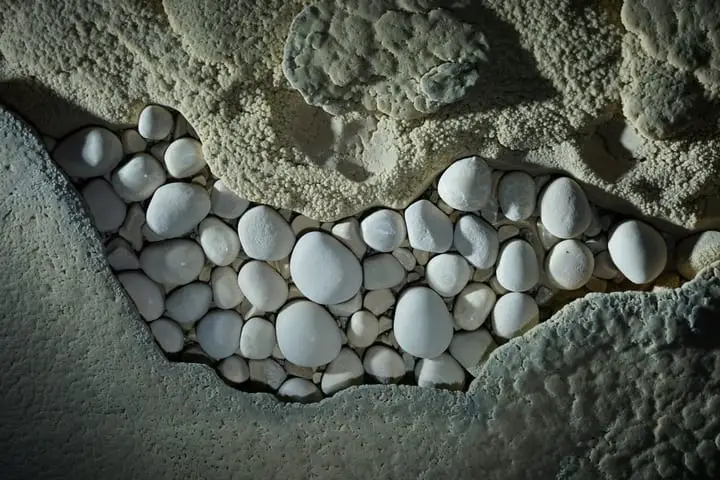
Broadgates Blogspot
The way in which these pearls are formed is by the dripping of calcite-heavy water onto dirt. The result is the smoothly shaped clumps of dirt we have here. After enough time, these deposits form solid rocks with a new look and glaze. they’re definitely worth the sight.
26. Unknown depths
In some caves, the bottom has yet to be found. Caves and expeditions navigate through hundreds of narrow meanders, always coming across more to traverse. In this cave, scientists have only gone as far as their supplies would enable them. And this isn’t even close to the bottom.
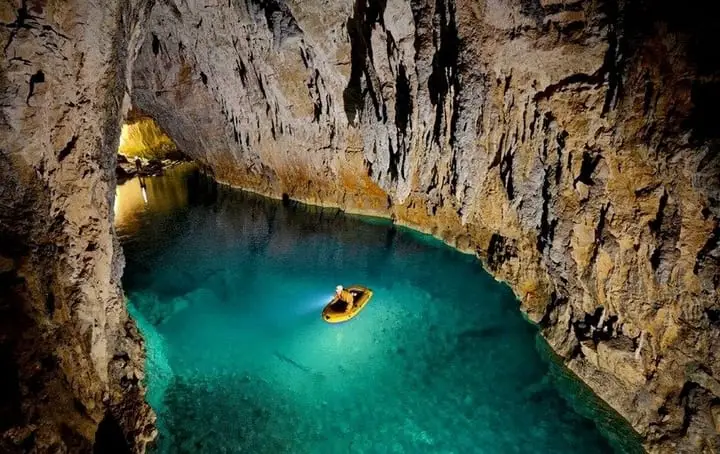
Travelpluss
The Krubera Cave in the Republic of Georgia is one of the deepest caves we know. The farthest anyone has yet to travel downward is 6,824 feet. People continually break the record and traverse deeper into the cave’s seemingly endless depths. What’s unique about this cave is that scientists and spelunkers set up campsites such that they can move through the cave with checkpoints.
27. Unknown depths: part two
When traveling this far into the Earth, it takes time. People sleep in tents up to around four or five, work 20 hour days, and spend weeks underground. Such disorienting feats drastically limit the ability of one to travel through the cave with much exuberance. You also frequently have to hike through freezing cold lakes of unknown composition.
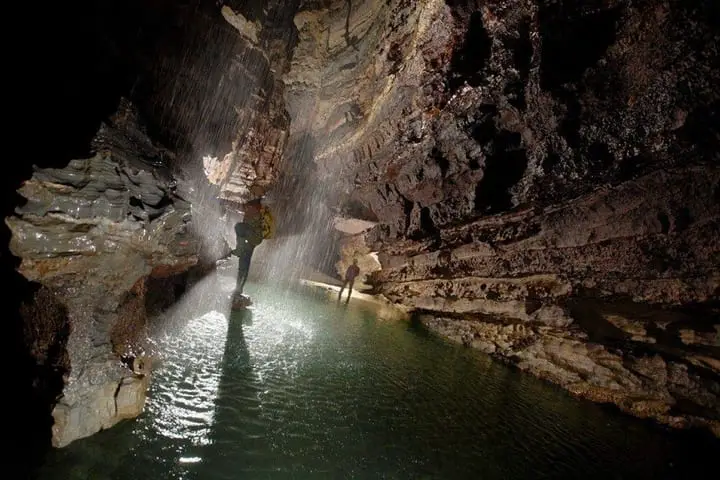
Styleatlife
In some instances, people have to squeeze through narrow tunnels that last something like 100 feet (and sometimes even more). Ultimately, the challenges with navigating through an unexplored cave can be difficult and arduous. The task takes an immense amount of time, and safety is paramount. It’s not, as they say, a walk in the park.
28. Blind fish
Many an animal has adapted to the cave life. Most of these have lost their eyes to the evolutionary process. This makes sense given that cave visibility is essentially zero. Bats, as we know, have developed finely tuned systems of echolocation. And the olm, as we mentioned earlier, developed a sixth sense for electricity. Here, however, we have a fish that’s adopted a new sense.
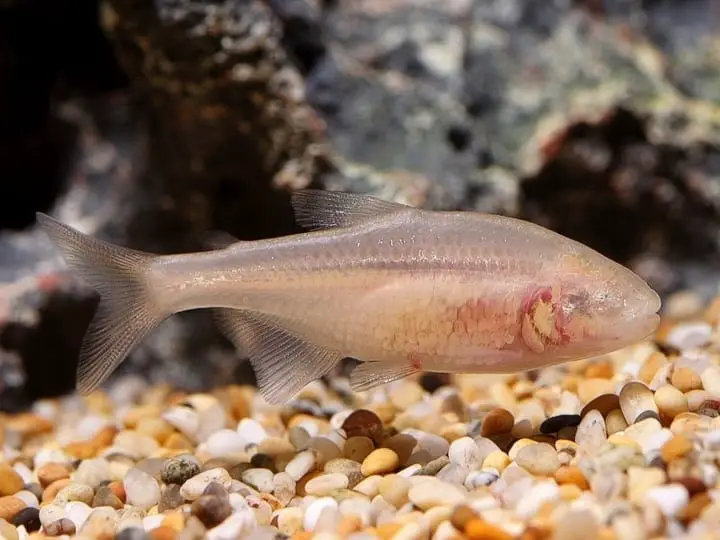
Leisure Pro
This fish can sense vibrations or pressure changes in the water. It uses what’s called its lateral line to do so. This lateral line is exactly what it sounds like (thanks, scientists): it runs from one end of the fish to another. It is responsible for detecting shifts in the vibrations of the surrounding environment, then channeling them up into the fish’s central nervous system. This allows it to understand its surroundings without the aid of sight.
29. Big ol’ crystals
As noted earlier, life was found in the center of some 50 million year old crystals. But what wasn’t pointed out was the crystals themselves. These sometimes 55-ton, 36 feet long crystals, are giant to say the least. They are, let’s just say, formidable beyond reason.
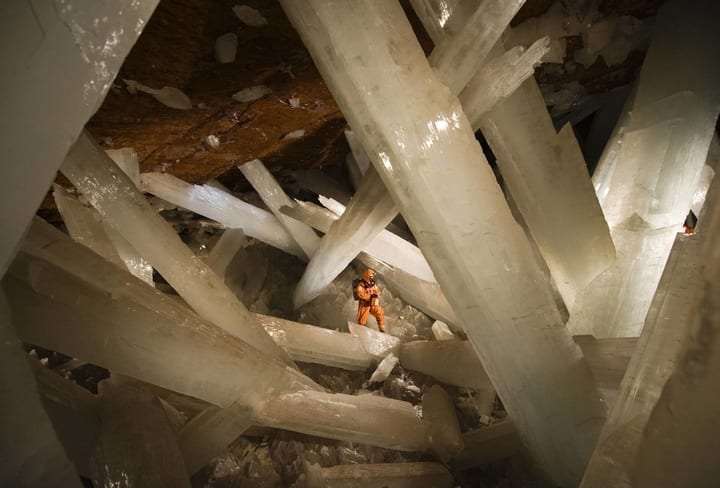
Penn State
These come from the aptly named Cave of Crystals in Naica, Mexico. While the crystals are definitely worth seeing, the environment of the cave is extraordinarily hostile. It’s around 118 degrees Fahrenheit, with a humidity of about 90 percent. This is warm and humid enough to kill a human in around 30 minutes—without the proper protection, of course.
30. The mystery of caves
So, as we’ve learned, caves are host to their own ecosystems, life, and color. There have fish with no eyes, weird-looking salamander things that can sense changes in electricity, and depths the likes of humans have never known. These combine to make caves one of the more mysterious formations in Earth’s crust.
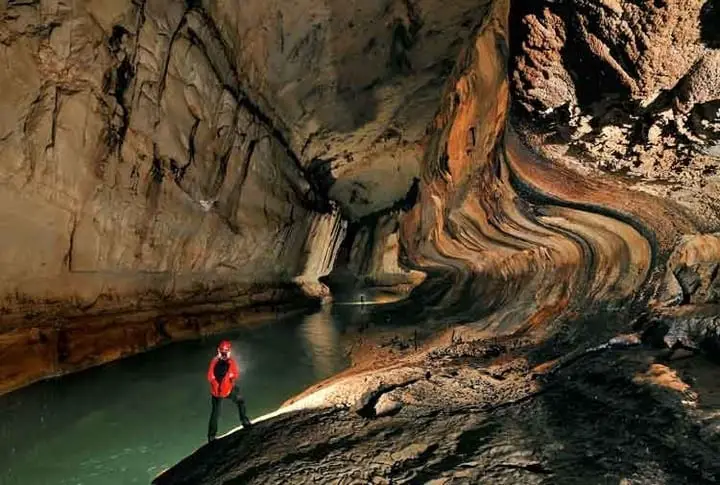
Alterra
As time moves forward, and as our time spent in caves increases, we will learn more about these mysterious environments and the gems they hold. The journey will be interesting, informative, and deeply revealing. Let’s look forward to these moments, whether creepy, mysterious, or entirely and unrelentingly satiating.